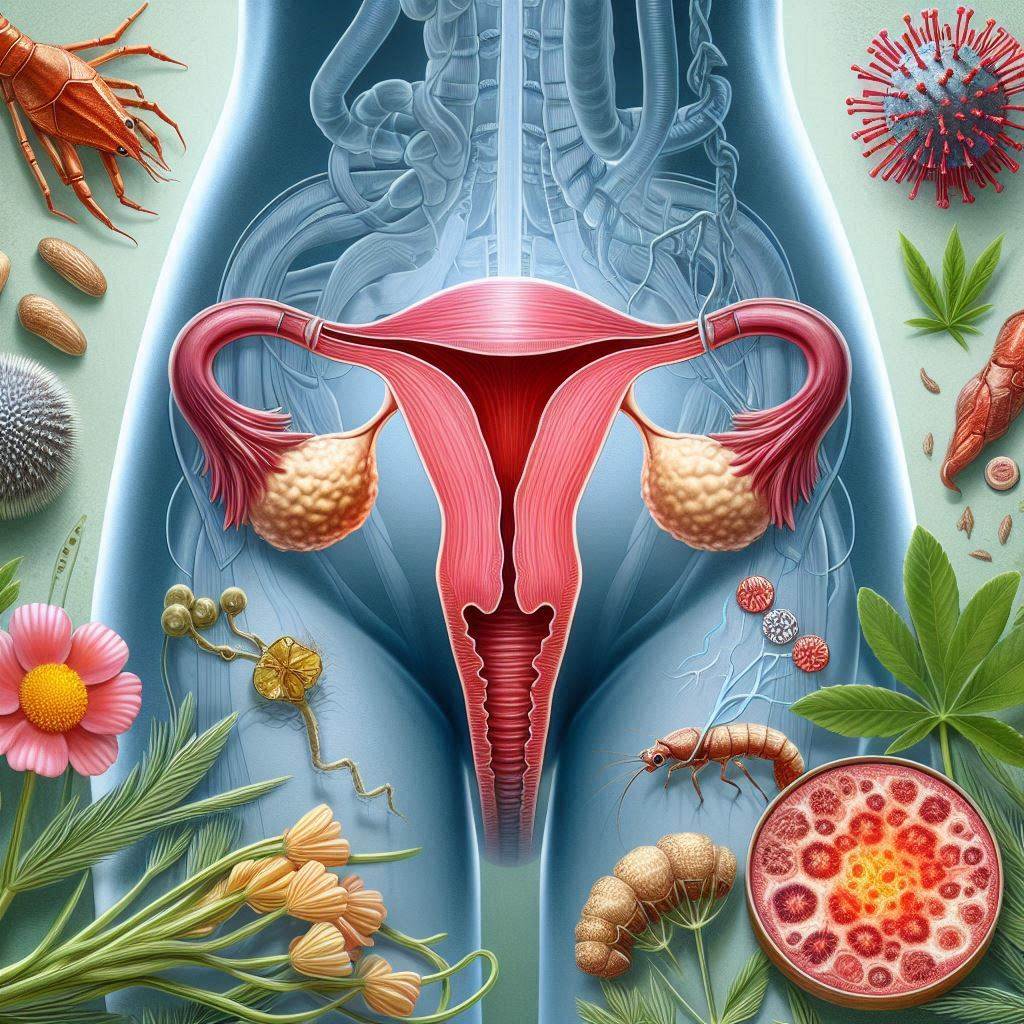Symptoms, Causes and How to Manage Fibroid (Uterine Fibroid) with Herbal Plants
Fibroids, also known as uterine fibroids or myomas, are non-cancerous growths that develop in or around the uterus. They are composed of smooth muscle cells and fibrous connective tissue. These growths can vary significantly in size, from as small as a grain of rice to as large as a melon.
Fibroids are quite common and often appear during the reproductive years. They can grow within the uterine wall, extend into the uterine cavity, or project outward from the uterus on stalks. While they are generally benign and not associated with an increased risk of uterine cancer, they can cause symptoms such as heavy menstrual bleeding, pelvic pain, and pressure on the bladder or bowel.
What are the Symptoms of Fibroid
The symptoms of fibroids can vary depending on their size, number, and location. Some women with fibroids experience no symptoms at all, while others may have significant discomfort. Here are some common symptoms:
- Heavy Menstrual Bleeding: This is one of the most common symptoms. It can include prolonged periods or bleeding between periods.
- Pelvic Pain and Pressure: Fibroids can cause a feeling of fullness or pressure in the lower abdomen or pelvis.
- Frequent Urination: If fibroids press on the bladder, they can cause a frequent need to urinate.
- Constipation: Pressure on the rectum can lead to difficulty with bowel movements.
- Backache or Leg Pains: Fibroids that press on nerves can cause pain in the back or legs.
- Pain During Intercourse: Some women experience pain during sexual activity.
- Enlarged Abdomen: Large fibroids can cause the abdomen to swell, making a woman look pregnant.
If you suspect you have fibroids or are experiencing any of these symptoms, it’s a good idea to consult with a healthcare provider for a proper diagnosis and treatment options.
Causes of Fibroid
The exact cause of fibroids is not fully understood, but several factors are believed to contribute to their development:
- Hormonal Factors: Estrogen and progesterone, the hormones that regulate the menstrual cycle, are thought to promote the growth of fibroids. Fibroids tend to grow during a woman’s reproductive years when hormone levels are higher and often shrink after menopause when hormone levels decrease.
- Genetic Changes: Many fibroids contain changes in genes that differ from those in normal uterine muscle cells.
- Growth Factors: Substances that help the body maintain tissues, such as insulin-like growth factor, may affect fibroid growth.
- Extracellular Matrix (ECM): ECM is the material that makes cells stick together. Fibroids have more ECM than normal uterine muscle cells, making them fibrous. ECM also stores growth factors and causes biological changes in the cells themselves.
- Other Factors:
- Family History: Having a family member with fibroids increases your risk.
- Pregnancy: Pregnancy increases the production of estrogen and progesterone in your body, which can stimulate fibroid growth.
- Age: Fibroids are more common as women age, especially during their 30s and 40s.
- Lifestyle Factors: Obesity, vitamin D deficiency, and excessive alcohol consumption have been linked to an increased risk of developing fibroids
Treatments for Fibroid
The treatment for fibroids depends on various factors, including the size, location, and number of fibroids, as well as the severity of symptoms and the patient’s desire for future pregnancies. Here are some common treatment options:
Medications
- Hormonal Therapy:
- Gonadotropin-Releasing Hormone (GnRH) Agonists: These medications reduce estrogen and progesterone levels, causing fibroids to shrink.
- Hormonal Birth Control: Pills, patches, or intrauterine devices (IUDs) can help control heavy bleeding and pain.
- Progestin-Releasing IUD: Helps reduce heavy bleeding caused by fibroids.
- Non-Hormonal Medications:
- Nonsteroidal Anti-Inflammatory Drugs (NSAIDs): Help relieve pain associated with fibroids.
- Tranexamic Acid: A non-hormonal medication that helps reduce heavy menstrual bleeding.
Non-Surgical Procedures
- Uterine Artery Embolization (UAE): This procedure blocks the blood supply to fibroids, causing them to shrink.
- MRI-Guided Focused Ultrasound Surgery (FUS): Uses high-frequency sound waves to destroy fibroid tissue.
- Endometrial Ablation: Destroys the lining of the uterus to reduce menstrual bleeding.
Surgical Options
- Myomectomy: Surgical removal of fibroids while preserving the uterus. This is often recommended for women who wish to maintain fertility.
- Hysterectomy: Complete removal of the uterus. This is a definitive solution for fibroids but is only recommended when other treatments have failed or are unsuitable.
Lifestyle and Home Remedies
- Diet and Exercise: Maintaining a healthy weight and diet can help manage symptoms.
- Stress Management: Techniques like yoga and meditation can help alleviate symptoms.
It’s important to discuss with your healthcare provider to determine the best treatment plan based on your specific situation.
Herbal Treatment for Fibroid
There are several herbal remedies that have been traditionally used to manage fibroids. While scientific evidence supporting their effectiveness varies, some herbs have shown promise in reducing fibroid size and alleviating symptoms. Here are a few commonly mentioned herbal treatments:
- Turmeric (Curcuma longa): Known for its anti-inflammatory properties, turmeric may help reduce fibroid size and alleviate symptoms.
- Chasteberry (Vitex agnus-castus): This herb is believed to balance hormone levels, which can help manage fibroid growth.
- Milk Thistle (Silybum marianum): Often used to support liver health, milk thistle may help the body process and eliminate excess hormones.
- Dandelion Root (Taraxacum officinale): This herb supports liver function and may help regulate hormones.
- Green Tea Extract: Contains antioxidants that may help reduce the size and number of fibroids.
- Blackstrap Molasses: Rich in iron and other nutrients, it is often used to help manage heavy menstrual bleeding associated with fibroids.
- Castor Oil Packs: Applied externally, castor oil packs are believed to improve circulation and promote healing of the tissues
How to Use These Herbs
- Teas and Infusions: Many of these herbs can be consumed as teas or infusions.
- Supplements: Herbal supplements are available in capsule or tincture form.
- Topical Applications: Castor oil packs can be applied to the abdomen.
Important Considerations
- Consult a Healthcare Provider: Before starting any herbal treatment, it’s important to consult with a healthcare provider, especially if you are taking other medications or have underlying health conditions.
- Quality and Dosage: Ensure you use high-quality herbs and follow recommended dosages.
Prevention of Fibriod Uretina
While there is no guaranteed way to prevent fibroids, certain lifestyle choices and health practices may help reduce the risk of developing them. Here are some strategies that might help:
Healthy Diet
- Increase Fruits and Vegetables: A diet rich in fruits and vegetables may help reduce the risk of fibroids.
- Limit Red Meat: High consumption of red meat has been linked to an increased risk of fibroids.
- Whole Grains: Incorporating whole grains into your diet can be beneficial.
Maintain a Healthy Weight
- Weight Management: Obesity is a risk factor for fibroids. Maintaining a healthy weight through diet and exercise can help reduce this risk.
Regular Exercise
- Physical Activity: Regular exercise can help maintain a healthy weight and balance hormone levels, which may reduce the risk of fibroids.
Hormonal Balance
- Manage Hormones: Hormonal imbalances can contribute to fibroid growth. Managing stress and avoiding exposure to environmental toxins that can disrupt hormones may help.
Vitamin D
- Adequate Vitamin D: Some studies suggest that vitamin D deficiency may be linked to fibroid development. Ensuring adequate vitamin D levels through sunlight exposure, diet, or supplements may help.
Limit Alcohol and Caffeine
- Reduce Alcohol and Caffeine Intake: Excessive consumption of alcohol and caffeine has been associated with an increased risk of fibroids.
Regular Check-Ups
- Routine Pelvic Exams: Regular visits to your healthcare provider can help detect fibroids early and manage them effectively.
While these strategies may help reduce the risk, they do not guarantee prevention. If you have concerns about fibroids or are experiencing symptoms, it’s important to consult with a healthcare provider for personalized advice and treatment options.









Review Fibroid (Uterine fibroid).
You must be logged in to post a review.